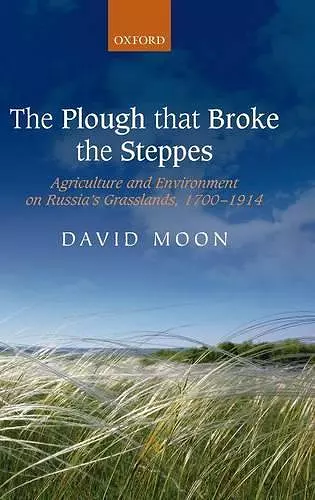The Plough that Broke the Steppes
Agriculture and Environment on Russia's Grasslands, 1700-1914
Format:Hardback
Publisher:Oxford University Press
Published:28th Feb '13
Currently unavailable, and unfortunately no date known when it will be back
This hardback is available in another edition too:
- Paperback£49.49(9780198722878)

This is the first environmental history of Russia's steppes. From the early-eighteenth century, settlers moved to the semi-arid but fertile grasslands from wetter, forested regions in central and northern Russia and Ukraine, and from central Europe. By the late-nineteenth century, they had turned the steppes into the bread basket of the Russian Empire and parts of Europe. But there was another side to this story. The steppe region was hit by recurring droughts, winds from the east whipped up dust storms, the fertile black earth suffered severe erosion, crops failed, and in the worst years there was famine. David Moon analyses how naturalists and scientists came to understand the steppe environment, including the origins of the fertile black earth. He also analyses how scientists tried to understand environmental change, including climate change. Farmers, and the scientists who advised them, tried different ways to deal with the recurring droughts: planting trees, irrigation, and cultivating the soil in ways that helped retain scarce moisture. More sustainable, however, were techniques of cultivation to retain scarce moisture in the soil. Among the pioneers were Mennonite settlers. Such approaches aimed to work with the environment, rather than trying to change it by planting trees or supplying more water artificially. The story is similar to the Dust Bowl on the Great Plains of the USA, which share a similar environment and environmental history. David Moon places the environmental story of the steppes in the wider context of the environmental history of European colonialism around the globe.
The vast grasslands of Ukraine and Russia come alive in David Moons careful analysis of the environmental history of the steppe. * Hans Werner, University of Winnipeg, The Mennonite Quarterly Review *
Rare is the book that casts Russian history in an almost wholly new light. * Financial Times 2013 Books of the Year *
Moons book is a wonderful and thoroughly researched analysis of the (not yet finished) processes of the scientific understanding of and agricultural adaptation to an environment that was once foreign to Russian farmers, but now iconic of them. * Douglas Weiner, European Review of History *
Moon's book is an extremely important contribution to Russian and environmental histories, and can be used in advanced undergraduate as well as graduate courses. * Mark Bernard Tauger, American Historical Review *
With this book, David Moon contributes significantly to the environmental history of the Russian and Soviet empires ... The book is thoroughly supported by extensive archival, journal and other research. I recommend it for students of European history, environmental history, Russian history and agricultural history. * Paul Josephson, European History Quarterly *
The Plough That Broke the Steppes is an important contribution to the global history of grassland ... Moon's work is both immensely readable and scholarly with a broad historical sweep and interdisciplinary scope. He brings life to scholarly, scientific, and practical agricultural debates on the steppes * Elizabeth Walden, Environmental History *
This stimulating book is the first environmental history of the Russian steppe, a flat plain that stretches from Western Russia to Mongolia, north of the Black and Caspian Seas ... Recommended. * N.M. Brooks, CHOICE *
In this impressively researched and compellingly argued book, David Moon elevates this problem of what to do with the fertile yet fragile belt of grasslands in Russia's south to one of the enduring 'cursed questions' of the country's history ... Throughout the book Moon evokes his personal experiences on the steppe. These environmental encounters clearly aided his historical thinking and provide vivid examples for the reader. Coming to know the grasslands themselves helped him write this insightful and lasting contribution to environmental and imperial Russian history. * Andy Bruno, History *
In the context of current discussions on the causes of climate change and the search for sustainable forms of agriculture, this work is a credit. * Katja Bruisch, Jahrbücher für Geschichte Osteuropas *
yet another wonderful and ground-breaking book from David Moon ... Throughout, Moon retains a moderate and scientific tone. * Christopher Read, English Historical Review *
- Winner of Winner of the 2013 Alexander Nove Prize (awarded 2015).
ISBN: 9780199556434
Dimensions: 240mm x 163mm x 25mm
Weight: 666g
344 pages